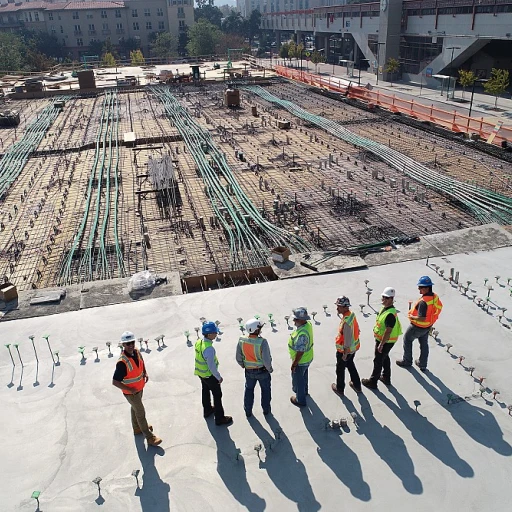Understanding the Importance of Career Development
The Role of Career Development in Employee Engagement
Career development is no longer just an added benefit in today’s corporate world; it is a critical component of employee engagement and retention. As organizations strive to create a motivated and skilled workforce, they understand the significant impact that career development has on both the employee and the company.
Employees often seek not just a job, but a career path that offers progression and professional growth. Providing career development opportunities is essential for meeting these aspirations. When individuals feel that their career goals align with the organizational growth objectives, they are more motivated to invest their best abilities in their work.
Furthermore, career development programs are crucial in helping employees acquire new skills and further hone existing ones through structured training development plans. This enhances their job satisfaction and opens doors for career advancement. With the right career development framework in place, organizations can ensure they are offering meaningful growth opportunities that pave the way for long-term career progression, benefiting both the employees and the company.
One of the ways organizations can foster career progression is by implementing comprehensive development programs. These initiatives should be carefully designed, considering both the employees' desires for professional growth and the company's objectives. A tailored approach can result in an engaged workforce that is dedicated to achieving shared goals.
For more insights on unique approaches to enhance employee engagement through professional development opportunities, explore the advantages of
unique digital learning solutions. These can serve as pivotal tools in crafting effective and sustainable career development plans.
Assessing Employee Needs and Organizational Goals
Recognizing Employee Aspirations and Aligning Them with Organizational Vision
Understanding employee aspirations and aligning them with organizational vision is crucial for the success of career development programs. Effective programs take into account both individual career goals and the overarching objectives of the company. This synergy not only promotes employee satisfaction and engagement but also bolsters the overall growth of the organization.
To begin, organizations should conduct assessments to identify employee career goals and their professional development needs. Such assessments can help in creating personalized development plans that address specific skills and training requirements. Employees may express interest in various career paths or opportunities for career progression, and it is the responsibility of the organization to provide guidance and support to help employees achieve these goals.
Moreover, aligning career paths with the company's goals requires a strategic approach. Organizations must ensure that their long-term objectives are communicated clearly and that employees understand how their roles contribute to achieving these objectives. This alignment helps foster a sense of purpose and motivation among employees, encouraging them to actively participate in the development programs offered.
Companies should also assess their current workforce capabilities and identify any skill gaps that may exist. By aligning these skill gaps with employee aspirations, organizations can design targeted training programs that not only fulfill the professional development needs of employees but also help the organization stay competitive and innovative.
For more on how process improvement certifications can aid in addressing skill gaps and enhance employee retention, consider exploring this resource on
enhancing employee retention through process improvement certification. This can provide valuable insights into integrating process improvements into career development initiatives, ensuring both employee satisfaction and organizational profitability.
Designing a Comprehensive Career Development Framework
Creating a Structured Path for Career Progression
Developing a comprehensive career development framework is essential for fostering career growth among employees. A systematic plan not only aligns the career goals of employees with the organizational objectives, but also helps in identifying the necessary skills and competencies required for their progression.
To devise an effective development plan, organizations should consider the following steps:
- Map Career Paths: Identify various potential career paths within the organization. This helps in clarifying the progression opportunities available to employees and eases their journey towards career advancement.
- Set Clear Expectations: Define and communicate the specific skills and achievements necessary for progression at each step. This transparency aids employees in understanding the career goals they need to achieve.
- Incorporate Various Learning Opportunities: Provide a blend of on-the-job training, mentorship, and formal learning programs. This diversity in training development ensures that employees are equipped with the required knowledge and skills for career advancement.
An effective career plan addresses the diverse needs of employees and fosters a culture of continuous professional development. A well-designed framework not only motivates employees but also enhances their engagement and long-term commitment to the company. To explore more about crafting an impactful evaluation for employee retention, visit
crafting effective 360-degree evaluation questions for employee retention.
Implementing the Career Development Program
Rolling Out Your Career Development Program with Precision
Implementing a career development program is a strategic move that requires careful planning and execution. For successful integration of such programs into the organizational fabric, it’s essential to adopt a step-by-step approach that aligns with both the company’s objectives and the career aspirations of the employees.
First, clear communication is key. Informing employees about the new career development program and its benefits is crucial to garner interest and motivate participation. Highlight where the program fits within the larger framework of the company’s goals and how it contributes to individual career growth.
Once the employees are informed, it’s vital to equip them with the necessary tools and resources for a seamless transition. Providing employees with comprehensive training and learning opportunities that focus on developing key skills is a significant step forward.
Next, creating specific career development plans tailored to individual career paths can substantially boost employee engagement. These plans should outline clear career progression trajectories, incorporating personalized goals aligned with both the employee's and the company's long-term objectives.
Regular feedback and continuous improvement cycles should be integrated to keep the program relevant and effective. Encourage open channels of communication between employees and management to discuss career development needs and any technical or professional support required.
Lastly, involve management in championing the program. When leaders invest themselves in these development programs, it signals their commitment to employee growth, boosting morale and fostering a culture of development.
To sum up, the implementation phase is crucial and can be the make-or-break stage for your organization’s career development efforts. Ensuring a smooth rollout of the program will lay a strong foundation for future growth, job satisfaction, and ultimately, advance both employee and organizational success.
Monitoring and Evaluating Program Effectiveness
Tracking Progress of Career Development Programs
Effectively monitoring and evaluating career development programs within an organization is crucial to ensure they align with both employee career aspirations and organizational goals. The progress tracking process not only aids in measuring the success of the programs but also identifies areas for further improvement.
To begin, it's essential for organizations to establish clear metrics to evaluate the effectiveness of the implemented career development initiatives. Consider factors such as employee engagement, skill acquisition, and career progression when setting these benchmarks. Utilize employee feedback systems, such as surveys or focus groups, to gather insights on how the development plans resonate with employees and how they contribute to their professional growth.
Businesses should also employ a variety of evaluation tools to gather a holistic view of program success:
- Regular Check-ins: Schedule consistent check-ins with employees to discuss their career development progress, assess any changes in their career goals, and adjust development plans accordingly.
- Performance Metrics: Utilize performance metrics to measure skills improvement and career growth opportunities provided by the program.
- Feedback Mechanisms: Implement feedback loops where employees can share their learning experiences and suggest improvements to the training development.
It’s important for companies to foster a culture of continuous learning and improvement. Encouraging a feedback-rich environment not only enhances the effectiveness of career development programs but also strengthens employee commitment to their career paths and the organization.
Ultimately, organizations should remain adaptable, ready to make necessary changes based on the gathered data and insights. Addressing challenges head-on and consistently refining the plan will help employees achieve their career advancement goals while ensuring that the organization remains competitive and meets its long-term objectives.
Overcoming Challenges in Career Development Initiatives
Addressing and Mitigating Career Development Roadblocks
Navigating the intricacies of employee career development comes with its fair share of challenges. While the intent might be well-meaning, effectively implementing a career development program requires a strategic approach to overcome potential hurdles.
Aligning Interests and Resources
Comprehensive career development frameworks demand significant resources. However, the alignment between organizational resources and employee career goals is paramount. Assessing both employee needs and organizational goals lays the groundwork for a cohesive strategy.
Building an Adaptive Learning Environment
Creating an environment that fosters learning and growth opportunities is crucial for long-term success. Modern career growth strategies must include multifaceted training development programs tailored to employees' unique skill sets and aspirations. Companies should focus on dynamic learning opportunities that adapt to evolving professional development trends and allow seamless progression along desired career paths.
Enhancing Communication and Feedback
Open lines of communication prevent misunderstandings and misalignments in career progression plans. Employers should regularly engage in feedback sessions with employees, understanding how training and development plans are perceived. This continuous dialogue helps make necessary adjustments, ensuring alignment with both employees' career aspirations and the company’s long-term goals.
Empowering Employees with Growth Tools
Equipping employees with the necessary tools for career advancement is essential. Organizations should provide access to professional development resources, clearly outline career paths within the organization, and offer mentorship programs that emphasize career pathing and job rotation opportunities.
Measuring and Celebrating Success
Monitoring and evaluating program effectiveness can be daunting. Nonetheless, establishing clear metrics for success and regular assessment intervals can help track progress and ensure employee engagement. Recognizing achievements and celebrating milestones fosters a culture of progression and encourages further participation in development programs.













